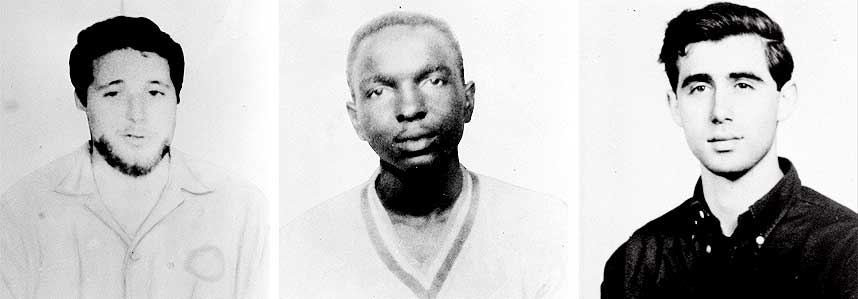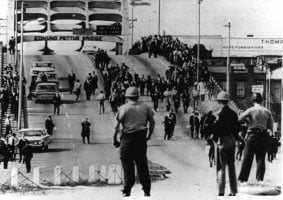Freedom Summer, 1964 (Edexcel GCSE History): Revision Note
Exam code: 1HI0
Summary
Despite the victories in the Supreme Court, ‘Jim Crow’ Laws and segregation still existed in many places in the South in the 1960s. As a result, Civil Rights groups attempted to increase the registration of Black voters and campaign to overturn discriminatory state voting laws. The Freedom Summer saw volunteers training Black voters how to pass the tests required to vote but resulted in a racist backlash. This included the notorious Mississippi Murders when three young activists were killed by the Ku Klux Klan (KKK)
In 1965, a march from Selma to Montgomery was organised by Martin Luther King to protest against state laws that prevented Black people from voting. This too led to vicious attacks on the people in the march but this time the attackers were law enforcement officials. When they used teargas and clubs to stop the march, over 50 demonstrators were left hospitalised.
Why was the freedom summer established?
The Freedom Summer was established after the New York Times newspaper reported in 1964 that only 7% of Mississippi’s Black population were eligible to vote
This was the lowest percentage of Black registered voters in the US
It also reported that many ‘Jim Crow’ state laws still existed in Mississippi
This motivated the Student Nonviolent Coordinating Committee (SNCC), the National Association for the Advancement of Coloured People (NAACP) and the Congress of Racial Equality (CORE) to target Mississippi in 1964 in a campaign they called the ‘Freedom Summer’
They formed the Mississippi Freedom Party
With the help of 80,000 volunteers, they created 30 Freedom Schools to teach the Black people of Mississippi how to pass the literacy tests
Under the Jim Crow laws, it was necessary to pass these tests before they could vote
Many of the volunteers at the Freedom Schools were White college students
They received training on how to cope with harassment, abuse and arrest
The Mississippi Freedom Party leaders believed attacking and arresting White volunteers would attract more publicity
Of the 17,000 Black people of Mississippi who applied to register to vote, only 1,600 were successful
Opposition & the Mississippi Murders
In response to the Freedom Summer, more than 30 Black Mississippi churches were firebombed
The freedom schools and volunteers were also attacked
In June 1964, three volunteers named James Chaney, Michael Schwerner and Andrew Goodman were arrested for traffic offences by a police officer who belonged to the KKK
Although they were released hours later, they were never seen alive again
After six weeks of searching, the bodies of the three men were eventually discovered
The police officer had organised their murders with his fellow Klan members
The investigation led to 18 people being arrested; seven were found guilty of the murders
The longest sentence served by the killers was six years

The murder of volunteers Andrew Goodman, James Chaney and Michael Schwerner attracted enormous publicity. Some claimed that the publicity was only due to two of the victims being White
Segregation in Selma, Alabama
The Civil Rights Act of 1964 left many people unsatisfied because it did not completely ban voter discrimination in individual states
Different rules could still apply to Black voters compared to White voters
The Southern Christian Leadership Conference (SCLC) and the SNCC decided to publicise and challenge this remaining discrimination in the town of Selma, Alabama in 1965
They chose Selma for their protest as it had a majority Black population and yet had just 383 registered Black voters out of a population of 15,000
This was the lowest rate of Black voter registration in Alabama
Martin Luther King & Selma, Alabama
By 1965, Martin Luther King had been awarded the Nobel Peace Prize and been named Time Magazine’s ‘Man of the Year’
His actions attracted enormous publicity and, after failing to get Black voters registered in Selma for two months, he decided to organise a march
The march was to travel from Selma to Montgomery, the state capital of Alabama, to deliver a petition to the state governor demanding equal rights for Black voters
The first march, on 7 March 1965, involved 600 protesters
King was not present because he was scheduled to speak at a church in Atlanta, Georgia
As they reached the Edmund Pettus Bridge, the marchers were attacked by state troopers who used tear gas, clubs and whips
More than 50 demonstrators were hospitalised and the march turned back to Selma
The day became known as ‘Bloody Sunday’

On 9 March King led more than 2,000 demonstrators over Edmund Pettus Bridge but, after agreeing with President Johnson to avoid another violent clash, he turned back before reaching Montgomery
On 21 March, King led a march of over 25,000 people from Selma to Montgomery where they successfully and peacefully presented the petition
Examiner Tips and Tricks
Remember, historical sources were created at the time of the period you are studying. Interpretations were created sometime after by people who have consulted a range of sources

Unlock more, it's free!
Did this page help you?